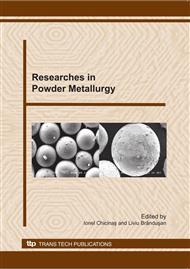p.293
p.297
p.303
p.307
p.311
p.315
p.319
p.323
p.327
Research on the Manufacture of some Tungsten-Copper Composite after Vacuum Sintering
Abstract:
The paper presents the results of the experimental research carried out in order to obtain pseudoalloys WNiCu used in electrical industry, for the electrical apparatus of high tension and great power. As a result it was compulsory to study the parameters that influence the densification process and the sintered properties, depending on the grain-size distribution of tungsten powder, compaction pressure and sintering temperature in vacuum. Therefore, it has been studied the influence of these parameters on the density, hardness and microstructures changes for the composites with 78%W-2%Ni-20%Cu, (% wt). The better results were obtained for the value of 1350 0C for the copper infiltration temperature.
Info:
Periodical:
Pages:
311-314
Citation:
Online since:
January 2011
Price:
Сopyright:
© 2011 Trans Tech Publications Ltd. All Rights Reserved
Share:
Citation:


